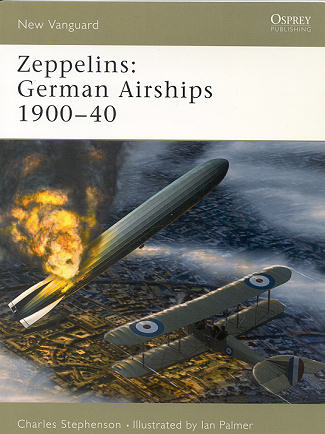 Zeppelins were
initially a German development of German engineering and two firms were involved
in building these large rigid airships. One was Schütte-Lang and the other,
which most of us know, is Zeppelin. Thanks to the enthusiasm of Count von
Zeppelin, these rigid airships were somewhat prominent during WWI and in the
period after. Of course, the whole genre of these rigid airships was fraught
with disasters of one sort or another, culminating in the very spectacular
destruction of the Hindenburg in 1937, eventually putting a screeching
halt to the production of any more after the launching of the Graf Zeppelin
II in 1938. In fact, this last airship was only flown sporadically and only
with military crews before it and the very successful Graf Zeppelin I (an
airship that made over 500 flights and flew over 1.7 million kilometers without
incident) were scrapped in 1940.
Zeppelins were
initially a German development of German engineering and two firms were involved
in building these large rigid airships. One was Schütte-Lang and the other,
which most of us know, is Zeppelin. Thanks to the enthusiasm of Count von
Zeppelin, these rigid airships were somewhat prominent during WWI and in the
period after. Of course, the whole genre of these rigid airships was fraught
with disasters of one sort or another, culminating in the very spectacular
destruction of the Hindenburg in 1937, eventually putting a screeching
halt to the production of any more after the launching of the Graf Zeppelin
II in 1938. In fact, this last airship was only flown sporadically and only
with military crews before it and the very successful Graf Zeppelin I (an
airship that made over 500 flights and flew over 1.7 million kilometers without
incident) were scrapped in 1940.
The author takes us on a trip through the development and deployment of
German rigid airships, through the bombing campaigns of WWI, and through the
passenger service of them in the 20s and 30s.
Though they struck fear into the populace of those under their bombs, they
were quite ineffective compared to aircraft and were very vulnerable to aircraft
incendiary ammunition whenever an airplane could get close enough to fire at
them.
Post war, many were built for the victorious Allied powers as part of war
reparations, though their service was short. The US Navy had one built as a
reparation (the USS Los Angeles), where it was used to test the trapeze system
used on the other dirigibles. Two others,
the Akron and Macon were build in conjunction with the Zeppelin works and are
remembered as aerial 'aircraft carriers' with their Sparrowhawk fighter. Yet
they succumbed to weather within two years of launch. The sad fact is that
they were just too vulnerable to weather to be practical. There was also little
technological difference between the Zeppelin of 1900 and the Hindenburg of
1937, while aircraft went from the Wright Flyer to the Spitfire in the same
amount of time.
A fascinating book with excellent pictures and superb profiles and artwork. A
worthy entry into the New Vanguard series and one that you will find most
enjoyable.
July 2006
Thanks to me for providing the review sample. For more on the complete line of Osprey books, visit
www.ospreypublishing.com
If you would like your product reviewed fairly and quickly by
a site that has over 300,000 visitors a month, please
contact me or see other details in the Note to Contributors.
 Zeppelins were
initially a German development of German engineering and two firms were involved
in building these large rigid airships. One was Schütte-Lang and the other,
which most of us know, is Zeppelin. Thanks to the enthusiasm of Count von
Zeppelin, these rigid airships were somewhat prominent during WWI and in the
period after. Of course, the whole genre of these rigid airships was fraught
with disasters of one sort or another, culminating in the very spectacular
destruction of the Hindenburg in 1937, eventually putting a screeching
halt to the production of any more after the launching of the Graf Zeppelin
II in 1938. In fact, this last airship was only flown sporadically and only
with military crews before it and the very successful Graf Zeppelin I (an
airship that made over 500 flights and flew over 1.7 million kilometers without
incident) were scrapped in 1940.
Zeppelins were
initially a German development of German engineering and two firms were involved
in building these large rigid airships. One was Schütte-Lang and the other,
which most of us know, is Zeppelin. Thanks to the enthusiasm of Count von
Zeppelin, these rigid airships were somewhat prominent during WWI and in the
period after. Of course, the whole genre of these rigid airships was fraught
with disasters of one sort or another, culminating in the very spectacular
destruction of the Hindenburg in 1937, eventually putting a screeching
halt to the production of any more after the launching of the Graf Zeppelin
II in 1938. In fact, this last airship was only flown sporadically and only
with military crews before it and the very successful Graf Zeppelin I (an
airship that made over 500 flights and flew over 1.7 million kilometers without
incident) were scrapped in 1940.